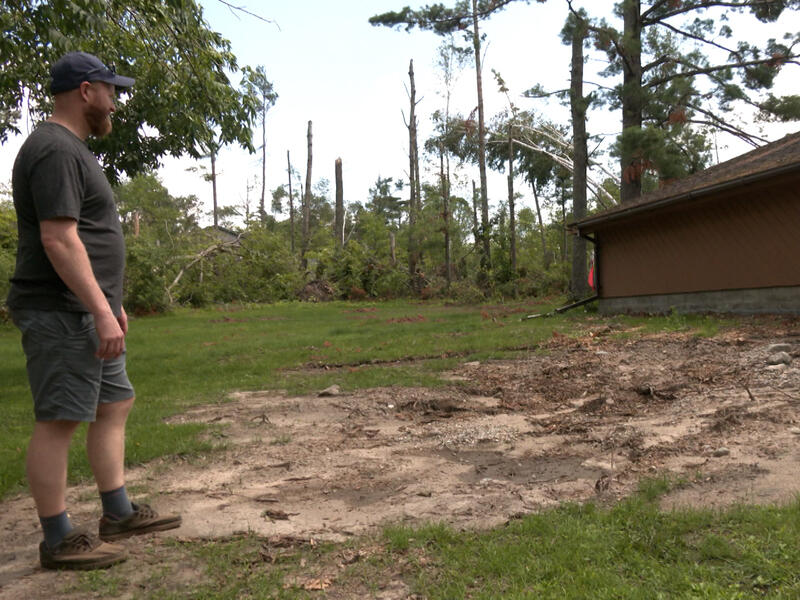The severe thunderstorm that blew through Bemidji, Minnesota, on June 21 impacted so many in the area. Homes were damaged, trees uprooted, lives altered forever.
Patients at Sanford Bemidji Medical Center also had to deal with power outages, and stifling heat and humidity.
People all across the region stepped up to help their neighbors after the storm, and Sanford employees were no different. That includes two unsung heroes who went above and beyond to get patients the care they needed in a slightly less traditional fashion.
Pilot temporarily trapped
Cole Schwerin and his family took shelter from the storm’s 120 mph wind gusts in the basement of their home around 12:30 a.m.
“It hits and we hear the wind and we hear, I think hail, and we hear a couple thuds and tree branches,” Schwerin said.
The next morning he couldn’t believe the damage.
“I would say 40 to 50 trees, probably out of maybe 60 in the yard. Man, we lost some big ones,” said Schwerin. “It missed the house by about two feet, which is insane.”
Schwerin is a helicopter pilot for Sanford AirMed, and initially he didn’t think he’d be able to make it to work.
“I’m walking around just baffled, taking pictures and videos, and I realized we can’t get out of our driveway,” Schwerin said.
‘An Uber to work’
With streets blocked by fallen trees all across the city, Schwerin knew people would need to be airlifted out of town. Even though he couldn’t drive to work, he walked down the street in search of an open field, which would be a perfect helicopter landing area.
“I’ve never been picked up to go to work. So I was super excited,” said Schwerin. “The crew was just giving me a lot of crap, you know. They were like, ‘Oh, Cole took an Uber into work today.’”
Jokes aside, Schwerin’s presence was important. His fellow pilots needed their mandatory rest time, so Schwerin was the only available pilot for part of the day. He would make three trips transporting patients from Bemidji to Fargo that day, and many more the rest of the week.
“It was like that for about three days straight,” Schwerin said. “It was nonstop.”
Luckily, by the end of his first shift, neighbors had helped clear his driveway, and his wife could pick him up from work in a car.
Keeping hospital supplies safe
At the hospital, power outages and lack of air conditioning made for a hot, humid night not just for patients, but for all of the medical equipment as well. Faith Johnshoy is the sterile processing manager at Sanford Bemidji Medical Center. As the storm blew through, her night was just getting started.
“We knew that there was going to be a storm. We didn’t know how bad it was going to be. So from midnight to about four o’clock in the morning, I was on the phone with staff contacting them, trying to navigate,” Johnshoy said.
Portions of the hospital roof were damaged, and water blew in through some side doors. The hospital was running on a backup generator. The heat and humidity made every instrument unsterile.
“If there’s any water that gets on a tray or peel pack, we do have to resterilize it,” Johnshoy said. “If the humidity is above 60%, we have to resterilize all the instruments after eight hours.”
Power outages meant sterilization machines were down as well.
“We had to divert all patients because we could not sterilely operate on anyone,” said Johnshoy. “If there was a true emergent life or death threat, then we would proceed. But we did not do anything further than that.”
Nonstop for six days
The morning of June 22 — more than 24 hours after the storm hit — the humidity came down and the sterilization machines were back up and running. The three machines ran constantly, with staff rotating in 24 hours a day. It took until June 27 for every piece of equipment to be completed.
“Theoretically, for a two-week pay period, our staff will assemble about four to five thousand items. At the end of that pay period, we were well over 12,000,” Johnshoy said.
It was a heavy lift, but one that was needed in a critical time.
“I cannot say how proud I am of my team, because I honestly did not think that it would go as smooth as it did,” Johnshoy said. “They really did put their hearts into it and try to do the best that they could so that we could see our patients throughout that week.”
Nurses and doctors are often the faces of a hospital, but there are so many people taking care of patients behind the scenes. Never was that more apparent than that fateful week in June. Cole Schwerin, Faith Johnshoy, and countless others all pitched in to help their patients and their neighbors weather the storm.
Learn more
- Sanford AirMed flies to save lives in summer traumas, more
- Emergency prep is everyday work for Army reservist
- Blizzard babies: The newest additions at Sanford Bismarck
…
Posted In Bemidji, Community, Emergency Medicine, People & Culture, Sanford Stories

